As a cat parent, you do everything within your means to ensure your cat is healthy. By choosing the best food, scheduling routine vet check-ups, and engaging in other activities that ensure your cat’s wellbeing.
But do you ever consider their dental health? According to the Journal of Feline Medicine and Surgery of 2019, research shows that periodontal disease is the most commonly diagnosed specific disorder in cats, with a one-year prevalence of 15.2%.
This means your cat can suffer from various dental issues like gum disease, tooth decay, or even infection, and the symptoms could go unnoticed for about a year. Treating these problems can be costly, as many pet owners aren’t prepared for the expenses that come with dental procedures. This is why you need cat dental insurance in place. With it, you can offset the cost of preventive care and emergency treatments,
We will break down everything you need to know about cat dental insurance—what it typically covers, common exclusions, and how to choose the best plan for your feline companion. By the end, you will have a clear understanding of how to protect your cat’s teeth without unexpected financial surprises.
Why cat dental insurance is important

Many cat owners don’t realize that dental health plays an important role in their pet’s overall well-being. Just like in humans, poor oral hygiene in cats can lead to pain, infections, and even serious health complications that affect other parts of the body. However, because cats hides their pain, dental problems can go unnoticed until they become severe.
Common dental problems in cats
Cats can develop a variety of dental issues, including:
- Gingivitis: Inflammation of the gums due to plaque buildup.
- Periodontal disease: A severe infection that can damage gums, teeth, and even the jawbone.
- Tooth resorption: A painful condition where a cat’s teeth break down and dissolve.
- Stomatitis: A severe and painful inflammation of the entire mouth.
What is cat dental insurance?

Cat dental insurance is a type of pet insurance that helps cover the costs of dental care, including cleanings, treatments for dental diseases, and sometimes even extractions or oral surgery. Just like human dental insurance, these policies help reduce out-of-pocket expenses for routine and emergency dental care, making it easier for pet owners to provide necessary treatments without financial stress.
Types of cat dental insurance coverage
Cat dental insurance can come in different forms:
- Accident-only plans: Covers dental injuries caused by accidents (e.g., broken teeth due to trauma) but does not cover disease-related treatments.
- Comprehensive pet insurance with dental coverage: Includes both accident-related dental issues and some treatments for dental diseases (e.g., periodontal disease, gingivitis). Coverage varies by provider.
- Standalone dental coverage (Add-ons): Some pet insurance companies offer dental add-ons to cover preventive care like cleanings, X-rays, and exams.
What does cat dental insurance covers?

Cat dental insurance covers a range of dental treatments that help maintain your feline’s oral health. However, coverage varies depending on the provider and plan. Some policies offer comprehensive dental coverage, while others may only cover treatments related to accidents or specific illnesses.
- Routine dental cleanings (preventive care)
Routine cleanings help remove plaque and tartar buildup, preventing periodontal disease. While some pet insurance plans offer this as an add-on wellness package, many standard policies do not cover cleanings unless they are deemed medically necessary.
- Tooth extractions
If a cat has severe dental disease, fractured teeth, or an infected tooth, extractions may be required. Most accident and illness plans cover extractions for medical reasons but may not cover them if caused by lack of preventive care.
- Treatment for periodontal disease
Some comprehensive pet insurance plans include treatment for periodontal disease, including deep cleanings, gum treatments, and medication. However, many insurers classify periodontal disease as a pre-existing condition if diagnosed before coverage begins, meaning treatments may not be reimbursed.
- Dental injuries from accidents
If a cat breaks or fractures a tooth due to an accident—such as a fall, biting a hard object, or trauma from a fight—dental insurance often covers treatment, including repairs or extractions. This is typically included in standard accident and illness policies.
- Tooth resorption treatment
Tooth resorption is a common condition in cats where the tooth’s structure starts to break down. If covered, treatment may include pain management, extractions, or other necessary procedures. However, not all insurance companies include tooth resorption in their policies.
- Oral surgery
Some insurance plans cover oral surgeries for conditions like tumors, severe infections, or jaw fractures. This can include biopsies, tumor removals, and reconstructive procedures.
- Medications for dental-related conditions
If your cat requires antibiotics, pain relievers, or other medications due to a dental procedure or infection, pet insurance may cover these costs under its broader illness coverage.
What’s usually not covered?
While some policies offer extensive dental coverage, most exclude:
- Pre-existing conditions: If your cat had dental issues before enrolling, they won’t be covered.
- Cosmetic procedures, such as orthodontics or non-medically necessary tooth removal
- Routine dental cleanings: This is not covered by dental insurance unless it is added as part of a wellness package.
- Coverage for lack of preventive care: If dental disease progresses due to lack of routine cleanings, treatment may be denied.
What are the signs that my cat is suffering from dental problems?

Cats are good at hiding their pain, so a dental issue could go unnoticed until it becomes severe. However, some signs could indicate that your cat is suffering from dental issues.
- Bad Breath (Halitosis)
- Difficulty Eating or Dropping Food
- Red, Swollen, or Bleeding Gums
- Excessive Drooling (Ptyalism)
- Pawing at the Mouth or Face Rubbing
- Weight Loss or Reduced Appetite
- Visible Tartar or Discolored Teeth
- Swelling Around the Face or Jaw
- Chattering or Grinding Teeth
- Visible Loose or Missing Teeth
Can I prevent dental problems in my cat?

Yes! While some dental issues can’t be avoided, some of them can be prevented with proper care, like:
- Brush your cat’s teeth regularly
Brushing your cat’s teeth is one of the most effective ways to prevent plaque and tartar buildup. Use a cat-safe toothbrush and enzymatic toothpaste (never human toothpaste, as it contains toxic ingredients like fluoride and xylitol).
- Provide dental treats and chews
Dental treats and chew toys help scrape away plaque and promote gum health. Look for products approved by the Veterinary Oral Health Council (VOHC), which are designed to reduce tartar and freshen breath.
- Offer a dental diet
Some cat food brands offer dental-specific kibble designed to clean teeth while chewing. These formulas usually have a larger kibble size or special textures that help reduce plaque and tartar buildup.
- Use water additives and oral gels
Water additives act like a mouthwash for cats, helping to prevent bacteria buildup and freshen breath. Oral gels can also be applied directly to the gums to reduce plaque and inflammation.
- Schedule regular vet checkups and professional cleanings
Annual veterinary dental exams are important for catching early signs of gum disease, infections, or tooth decay.
- Monitor for early signs of dental issues
Look out for symptoms like bad breath, difficulty eating, or excessive drooling. Noticing dental issues early can prevent costly and painful treatments later on.
What is the cost of cat dental care?
Dental treatment for cats in the UK can be quite costly, often running into several hundred pounds. This is because most procedures, including routine cleanings and extractions, require general anaesthetic, which increases the cost. Since anaesthesia is involved, vets usually recommend completing all necessary treatments in a single visit to minimise stress and expenses.
The exact price of cat dental care varies depending on your vet practice, your cat’s specific needs, and the severity of any dental issues. Here is a breakdown for some of the common dental Below is an overview of typical costs for common feline dental treatments in the UK:
- Professional Teeth Cleaning (Scale and Polish): £150 to £400
If your cat has plaque and tartar buildup or early signs of gingivitis, they will need a professional dental cleaning. This procedure involves removing plaque, tartar, and bacteria from the teeth and gums under general anaesthetic. Costs will vary depending on the extent of the problem and your vet’s pricing structure.
- Tooth Extractions: £200 to £450 per tooth
Severe dental issues, such as abscesses, broken teeth, or retained baby teeth, may require tooth extraction. Since extractions involve anaesthesia and possible X-rays, the price can rise significantly, especially if multiple teeth need to be removed.
- Treatment for Periodontal Disease: £300 to £800
Advanced gum disease requires deep cleaning, medication, and sometimes oral surgery. If the infection is severe, multiple treatments may be necessary, increasing costs.
- Dental X-rays: £100 to £250
X-rays allow vets to assess the health of the teeth beneath the gum line, which is important for diagnosing conditions like tooth resorption. This procedure is usually an additional cost on top of dental cleanings or extractions.




